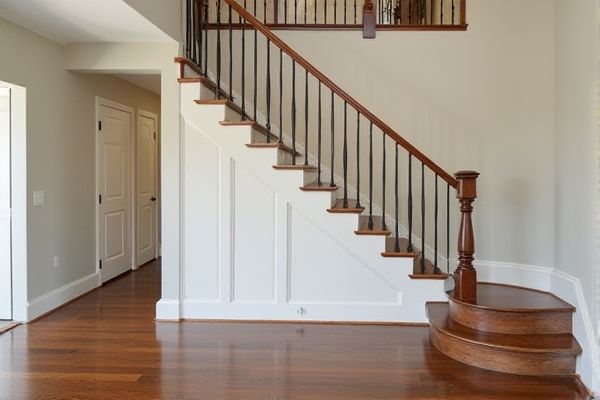
Alternating tread staircases maximize space efficiency by allowing a steeper ascent with staggered steps, making them ideal for tight areas, while traditional tread staircases offer a more comfortable and familiar design with evenly spaced steps. Discover which option best suits your space and safety needs in the detailed comparison ahead.
Table of Comparison
| Feature | Alternating Tread Staircase | Traditional Tread Staircase |
|---|---|---|
| Design | Unique alternating steps for compact space | Standard uniform steps |
| Space Efficiency | Highly space-saving, ideal for tight areas | Requires more floor and vertical space |
| Safety | Requires cautious use; steep and narrow | Safer with wider, consistent steps |
| Comfort | Less comfortable due to alternating steps | More comfortable for everyday use |
| Installation | Complex and customized installation | Standard installation process |
| Use Case | Best for lofts, attics, and tight spaces | Suitable for general residential and commercial |
| Cost | Usually higher due to unique design | Generally lower and widely available |
Overview of Alternating Tread and Traditional Staircases
Alternating tread staircases feature staggered steps designed to save space and allow steeper angles compared to traditional tread staircases, which use uniform steps for consistent foot placement and comfort. Traditional staircases prioritize ease of use and safety with a gradual incline, while alternating tread designs optimize compact areas where full stairs are impractical. Choosing the right staircase depends on your available space and the balance between convenience and spatial efficiency.
Key Design Differences
Alternating tread staircases feature staggered steps that allow for a steeper incline while maintaining safe foot placement, making them ideal for tight spaces. Traditional tread staircases have uniform steps with consistent depth and height, providing a more comfortable and familiar walking experience. Your choice depends on space constraints and ease of use, with alternating treads maximizing compactness and traditional treads prioritizing accessibility.
Space Efficiency Comparison
Alternating tread staircases maximize space efficiency by reducing the horizontal footprint by up to 50% compared to traditional tread designs, making them ideal for tight areas like lofts or compact apartments. Traditional staircases require more floor area due to their full-width treads and consistent rise, which can limit available living space. Choosing an alternating tread staircase can help you optimize square footage without sacrificing accessibility in small spaces.
Safety Considerations
Alternating tread staircases enhance space efficiency but require cautious navigation due to their unconventional step design, which can pose a higher risk of missteps compared to traditional tread stairs with uniform step depth. Traditional tread stairs offer greater stability and are generally considered safer for regular use, especially for individuals with mobility challenges or when carrying heavy objects. Ensuring proper handrails and adequate lighting is essential for both types to maintain safety in your environment.
Installation and Maintenance
Alternating tread staircases require precise installation due to their unique angled design, often necessitating professional expertise to ensure safety and compliance with building codes. Maintenance for alternating tread stairs involves regular inspection of the narrow treads and supports to prevent wear and structural issues, as their non-standard configuration may lead to faster deterioration if neglected. Traditional tread staircases are typically easier to install with standard measurements and materials, and their straightforward design simplifies routine cleaning and maintenance, promoting long-term durability.
Cost Analysis
Alternating tread staircases often require less material and space, resulting in lower initial construction costs compared to traditional tread staircases. Maintenance expenses tend to be similar, but alternating tread designs may incur higher costs if special safety features or custom fabrication are needed. Understanding your specific spatial constraints and budget will help determine which staircase type offers the best cost efficiency for your project.
Suitability for Residential and Commercial Spaces
Alternating tread staircases offer a space-saving solution ideal for tight residential areas or compact commercial environments where floor space is limited. Traditional tread staircases provide greater safety and comfort, making them more suitable for high-traffic commercial spaces and family homes where accessibility is a priority. Your choice depends on balancing space efficiency with ease of use and compliance with building codes.
Building Codes and Regulations
Alternating tread staircases must comply with specific building codes, such as the International Residential Code (IRC) Section R311.7.8, which permits their use only in space-constrained areas like lofts or attics, limiting their installation compared to traditional tread staircases. Traditional tread stairs are universally accepted under most building codes, offering consistent riser heights and tread depths to ensure safety and accessibility.
Aesthetic Impact on Interiors
Alternating tread staircases create a striking visual impact with their modern and minimalist design, often becoming a centerpiece in contemporary interiors. Traditional tread staircases offer timeless elegance and a sense of spaciousness, blending seamlessly with various architectural styles. Your choice influences the overall ambiance, where alternating treads emphasize innovation while traditional ones maintain classic charm.
Choosing the Right Staircase for Your Needs
Alternating tread staircases maximize space efficiency by allowing steeper angles and narrower dimensions compared to traditional tread stairs, making them ideal for compact areas. Traditional tread staircases provide greater comfort and safety with wider steps and consistent rise, suited for frequent use and accessibility. Selecting the right staircase depends on balancing spatial constraints, user safety preferences, and intended usage frequency.
 homyna.com
homyna.com